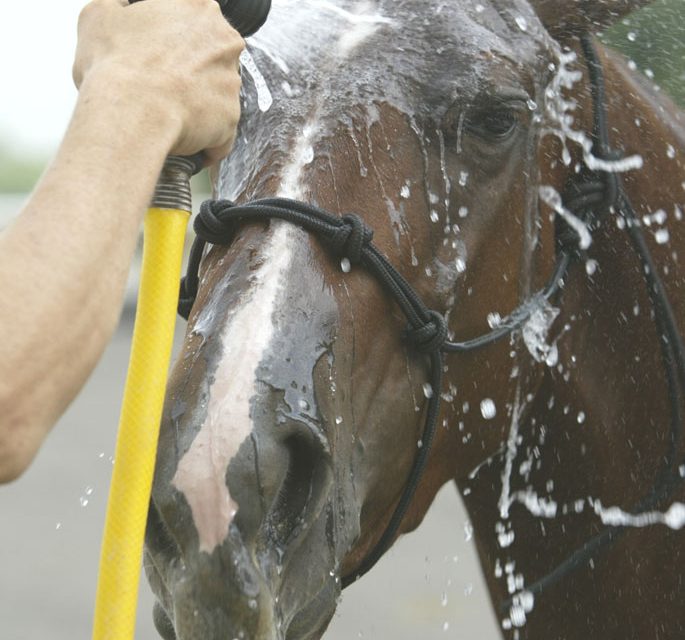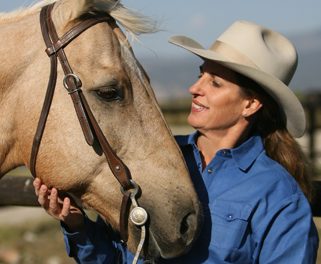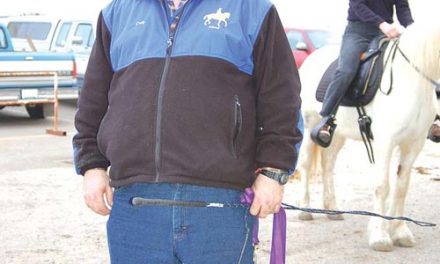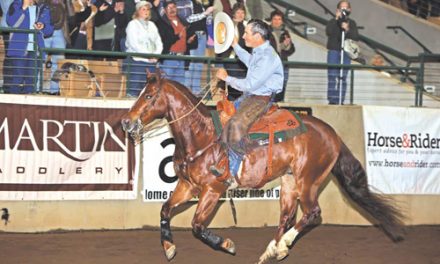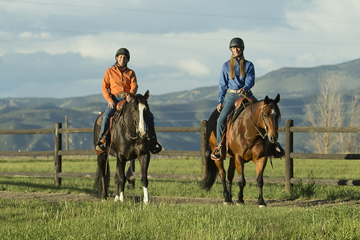A lot of people hate giving their horses baths because they know that the whole ordeal is going to be a struggle. The horse runs in a circle and constantly pulls away. Before long, the handler is soaked to the bone with soap suds clinging to her shirt, while the horse is standing off, spotlessly dry and having a good laugh.
Bathing doesn’t have to be a frustrating experience for you or your horse. If you follow my simple approach and retreat method—which allows your horse to gain confidence in new experiences—you’ll have him begging to be bathed.
Prepare the horse for bathing by first desensitizing him to the hose and water. Be sure to give him a chance to accept the experience. A success tip I’ll share with you is that the best time to desensitize your horse to bathing is after I’ve worked him and he’s tired, hot, and sweaty. You’ll be amazed at how fast horses will learn to love being hosed off if you do it after a workout.
Give Him Space
Do not tie a horse up when desensitizing him. I can’t stress that enough. Anytime a prey animal, which the horse is, feels trapped and claustrophobic and can’t move his feet, he’ll feel his only other option is to fight: kick, bite, rear, lunge, or strike. Instead, introduce the horse to the hose and water in an open area, where there’s plenty of room for him to move his feet.
A 50-foot round pen is a perfect place to get started. Any sort of open space is what you’re looking for. You don’t want to be worried about the horse ramming you against a wall or panicking and pulling back against whatever he’s tied to. Round pens are ideal places to work horses because they allow the horse to move, but you don’t need 300 feet of hose to stay with him. Wherever you decide to work with your horse, be sure that the hose is plenty long so that you can follow him if he does move.
Some places you definitely don’t want to desensitize your horse to bathing are in a wash rack or on concrete. Wash racks make a horse feel claustrophobic, and concrete, when wet, can get slippery and dangerous, causing the horse to fall over. Remember, tying a horse up is a very bad idea. If he’s frightened, his only option is to pull back against the halter and lead rope which could give him a serious neck injury
Stand in a Safe Position
When you have the horse in an open area, stand by his shoulder at a 45 degree angle. If the horse would strike, you’re too far to the side to get hit. Or, if he should kick at you, you’re too far forward to be reached. Then tip the horse’s head so that his eyes are focused on you, and you have his attention.
Spray Around the Horse
Start out by desensitizing the air space around the horse. The last thing you want to do is spray the horse with water right away. I usually start by spraying the ground around his back feet first. You might have to start by spraying the ground 4 feet away from him. It doesn’t matter where you begin, but find a starting point that your horse is comfortable with, and gradually work your way closer to his body. I begin by spraying the ground first because if the horse can’t tolerate the water next to his feet, there’s no way he’ll accept it on his body. If he wants to move away from water being sprayed next to his feet, let him, but don’t take the water away.
It’s important to keep the water next to the horse and follow him wherever he goes with the hose until he stands still and relaxes. If you take the water away from the horse when he’s moving away from you, you’ll only reinforce his wrong behavior. When a horse relaxes, he licks his lips, cocks a hind leg, takes a deep breath, blinks his eyes, lowers his head and neck or stands still for at least 15 seconds. Once he shows signs of relaxing, retreat and take the water away. Then repeat the whole process again until he’s completely comfortable with the water and doesn’t try to move away from it. You basically want to be able to spray water 360 degrees around the horse with the hose before you even think about touching his body with the water.
Stand the Horse
Start spraying water in the middle of the horse’s back, and then work your way down his hindquarters and up his neck. Stay away from his head until his body is reasonably comfortable. Approach with the water, and keep it in the middle of his back until he relaxes. As soon as he relaxes, take the water away, and then begin the process again.
Once the horse accepts water being sprayed on his body, move on to his back legs. A lot of horses will be defensive about water touching their lower legs at first, but the higher up you go, the less defensive they’ll be. Remember, if you take the water away when the horse moves, you’ll teach him that to escape the water all he has to do is run from it.
From the back legs, move the hose and water to the horse’s front legs, starting at the shoulder then going down. After that, switch sides and start to desensitize his other side to the water. Remember, when you switch sides of a horse, you switch brains. Each side of the horse thinks independently from the other, so when you introduce something new to your horse, you have to treat each side like you’re dealing with a completely different horse. Remember, whatever you do on one side, do to the other.
When you move on to the next side, start out by desensitizing the air space around the horse. Just like the first side, start by spraying the water next to his body. Then work your way to spraying water all over his body. Don’t worry about doing the horse’s head until he is comfortable with water being sprayed all over his body first.
Spray His Face
When I do decide to run water over the horse’s face, I don’t stand back and just spray him. Always give a horse the chance to accept new experiences. Horses aren’t necessarily worried about having water on their face; they’re really worried about getting water in their ears. When introducing water to a horse’s face, turn the pressure down on the hose to make it easier for the horse to accept it. Start out by laying the hose flat against the horse’s cheek, and let the water run down the side of his face. Then position the hose in the middle of his face and let the water run down. If the horse goes to move at any time, or if he lifts his head, keep the hose on his face and just follow him until he lowers it again. Use the same approach and retreat method as before. Once the horse stands still and relaxes with the water running down his face, retreat. When the horse is comfortable with low water pressure, you can gradually turn the pressure up.
About the author
Through his widely-popular Downunder Horsemanship program, Clinton Anderson works hard to educate horse owners on how to be safe and effective while enjoying their horses. His training methods are easy to understand and are designed to help horse owners get the results they desire. Clinton holds clinics and can be seen on RFD-TV. This Australian native is a two-time champion of the rigorous Road to the Horse Colt Starting Challenge, which gives trainers just three hours to break an unstarted colt. Learn more about Clinton at www.downunderhorsemanship.com.

